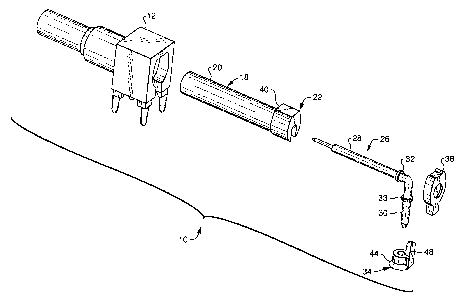Some of the information on this Web page has been provided by external sources. The Government of Canada is not responsible for the accuracy, reliability or currency of the information supplied by external sources. Users wishing to rely upon this information should consult directly with the source of the information. Content provided by external sources is not subject to official languages, privacy and accessibility requirements.
Any discrepancies in the text and image of the Claims and Abstract are due to differing posting times. Text of the Claims and Abstract are posted:
| (12) Patent Application: | (11) CA 2475645 |
|---|---|
| (54) English Title: | HIGH FREQUENCY RIGHT ANGLE CONNECTOR |
| (54) French Title: | CONNECTEUR HAUTE FREQUENCE A ANGLE DROIT |
| Status: | Deemed Abandoned and Beyond the Period of Reinstatement - Pending Response to Notice of Disregarded Communication |
| (51) International Patent Classification (IPC): |
|
|---|---|
| (72) Inventors : |
|
| (73) Owners : |
|
| (71) Applicants : |
|
| (74) Agent: | SMART & BIGGAR LP |
| (74) Associate agent: | |
| (45) Issued: | |
| (22) Filed Date: | 2004-07-21 |
| (41) Open to Public Inspection: | 2005-03-17 |
| Availability of licence: | N/A |
| Dedicated to the Public: | N/A |
| (25) Language of filing: | English |
| Patent Cooperation Treaty (PCT): | No |
|---|
| (30) Application Priority Data: | |||||||||
|---|---|---|---|---|---|---|---|---|---|
|
A high frequency, right angle socket (10) comprising a body (12) including a
longitudinal
bore (14) extending completely through the body (12) and a transverse bore
(16) intersecting
the longitudinal bore (14). The bores (14) and (16) are seen most clearly in
Fig. 5. A first
dielectric (18) is formed to fractionally engage the longitudinal bore (14).
The dielectric (18)
has a proximal end (20) and a distal end (22) and includes a longitudinal
electric
contact-receiving chamber (24). A right angle electrical contact (26) has a
longitudinal portion (28)
and a transverse portion (30). The longitudinal portion (28) includes a first
contact retainer
(32). The transverse portion (30) includes a contact retainer (33). The
longitudinal portion
(28) is fitted into the longitudinal electrical contact-receiving chamber (24)
of the first
dielectric (18) with the contact retainer (32) on the longitudinal portion
(28) engaging the
interior wall of the longitudinal contact-receiving chamber (24). A second
dielectric (34) is
formed to fractionally engage the transverse bore (16) and includes a
transverse electrical
contact-receiving chamber (36). The transverse portion (30) of the right angle
electrical
contact (26) is fitted into the transverse electrical contact-receiving
chamber (36) with the
contact retainer (33) on the transverse portion (30) engaging the interior
wall of the
transverse electrical contact-receiving chamber (36). A cap (38) closes one
end of the
longitudinal bore (14).
Note: Claims are shown in the official language in which they were submitted.
Note: Descriptions are shown in the official language in which they were submitted.

2024-08-01:As part of the Next Generation Patents (NGP) transition, the Canadian Patents Database (CPD) now contains a more detailed Event History, which replicates the Event Log of our new back-office solution.
Please note that "Inactive:" events refers to events no longer in use in our new back-office solution.
For a clearer understanding of the status of the application/patent presented on this page, the site Disclaimer , as well as the definitions for Patent , Event History , Maintenance Fee and Payment History should be consulted.
| Description | Date |
|---|---|
| Inactive: IPC assigned | 2018-04-12 |
| Inactive: First IPC assigned | 2018-04-12 |
| Inactive: IPC assigned | 2018-04-12 |
| Inactive: IPC expired | 2011-01-01 |
| Inactive: IPC expired | 2011-01-01 |
| Inactive: IPC removed | 2010-12-31 |
| Inactive: IPC removed | 2010-12-31 |
| Time Limit for Reversal Expired | 2009-07-21 |
| Application Not Reinstated by Deadline | 2009-07-21 |
| Deemed Abandoned - Failure to Respond to Maintenance Fee Notice | 2008-07-21 |
| Inactive: IPC from MCD | 2006-03-12 |
| Application Published (Open to Public Inspection) | 2005-03-17 |
| Inactive: Cover page published | 2005-03-16 |
| Inactive: First IPC assigned | 2004-11-16 |
| Filing Requirements Determined Compliant | 2004-09-10 |
| Letter Sent | 2004-09-10 |
| Inactive: Filing certificate - No RFE (English) | 2004-09-10 |
| Application Received - Regular National | 2004-09-07 |
| Abandonment Date | Reason | Reinstatement Date |
|---|---|---|
| 2008-07-21 |
The last payment was received on 2007-06-12
Note : If the full payment has not been received on or before the date indicated, a further fee may be required which may be one of the following
Please refer to the CIPO Patent Fees web page to see all current fee amounts.
| Fee Type | Anniversary Year | Due Date | Paid Date |
|---|---|---|---|
| Registration of a document | 2004-07-21 | ||
| Application fee - standard | 2004-07-21 | ||
| MF (application, 2nd anniv.) - standard | 02 | 2006-07-21 | 2006-06-19 |
| MF (application, 3rd anniv.) - standard | 03 | 2007-07-23 | 2007-06-12 |
Note: Records showing the ownership history in alphabetical order.
| Current Owners on Record |
|---|
| OSRAM SYLVANIA INC. |
| Past Owners on Record |
|---|
| JOHN SHERRY |
| MICHAEL J. SWANTNER |
| SHANE BROWN |